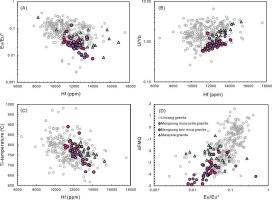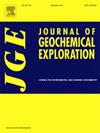临沧基底南部孟松矿床锡矿化的岩浆控制与年代学
IF 3.3
2区 地球科学
Q1 GEOCHEMISTRY & GEOPHYSICS
引用次数: 0
摘要
云南西南部三叠纪临沧花岗岩基发育大量与花岗岩有关的锡矿床。采用锆石UPb年代学、Hf同位素分析、微量元素地球化学等综合方法,对临沧基底南段孟松锡矿床进行了研究。孟松矿床锆石的结晶年龄为225.5±0.9 Ma (MSWD = 2.3, n = 20),白云母花岗岩为224.7±0.9 Ma (MSWD = 1.9, n = 25)。这表明孟松花岗岩形成于三叠纪。锆石微量元素特征表明孟松花岗岩是由低氧逸度岩浆分馏结晶而成(ΔFMQ)。负锆石εHf(t)值(- 14.3 ~ - 1.5)表明锆石来源于古地壳。我们认为还原岩浆是锡富集的基本前提。这一因素与古特提斯闭合后碰撞伸展过程中地壳熔体的高度岩浆分异相结合,为锡成矿创造了理想的条件。这些结果突出了孟松矿床锡矿化与同步花岗质岩浆作用的成因关系,为今后滇西南三叠系锡矿找矿提供了有价值的参考。本文章由计算机程序翻译,如有差异,请以英文原文为准。

Magmatic controls and chronology of tin mineralization in the Mengsong Deposit, Southern Lincang Batholith, SW China
The Triassic Lincang granite batholith in southwestern Yunnan, China, hosts numerous granite-related tin deposits. This study investigates the Mengsong tin deposit, located in the southern part of the Lincang batholith, by integrating zircon U![]() Pb geochronology, Hf isotopic analysis, and trace element geochemistry. Zircon from the Mengsong deposit reveals crystallization ages of 225.5 ± 0.9 Ma (MSWD = 2.3, n = 20) for the muscovite granite and 224.7 ± 0.9 Ma (MSWD = 1.9, n = 25) for the two-mica granite. This indicates that the Mengsong granites was formed during the Triassic period. Zircon trace element signatures indicate that the Mengsong granites are highly fractionated and crystallized from magmas with low oxygen fugacity (ΔFMQ). Negative zircon εHf(t) values (−14.3 to −1.5) indicate derivation from an ancient crustal source. We propose that reduced magmas were fundamental prerequisite for tin enrichment. This factor, in conjunction with highly magmatic differentiation of crustal melts generated during post-collisional extension after the Paleo-Tethys closure, created the ideal conditions for Sn mineralization. These results highlight the genetic relationship between tin mineralization and synchronous granitic magmatism in the Mengsong deposit and provide valuable insights for future exploration targeting Triassic tin systems in southwestern Yunnan.
Pb geochronology, Hf isotopic analysis, and trace element geochemistry. Zircon from the Mengsong deposit reveals crystallization ages of 225.5 ± 0.9 Ma (MSWD = 2.3, n = 20) for the muscovite granite and 224.7 ± 0.9 Ma (MSWD = 1.9, n = 25) for the two-mica granite. This indicates that the Mengsong granites was formed during the Triassic period. Zircon trace element signatures indicate that the Mengsong granites are highly fractionated and crystallized from magmas with low oxygen fugacity (ΔFMQ). Negative zircon εHf(t) values (−14.3 to −1.5) indicate derivation from an ancient crustal source. We propose that reduced magmas were fundamental prerequisite for tin enrichment. This factor, in conjunction with highly magmatic differentiation of crustal melts generated during post-collisional extension after the Paleo-Tethys closure, created the ideal conditions for Sn mineralization. These results highlight the genetic relationship between tin mineralization and synchronous granitic magmatism in the Mengsong deposit and provide valuable insights for future exploration targeting Triassic tin systems in southwestern Yunnan.
求助全文
通过发布文献求助,成功后即可免费获取论文全文。
去求助
来源期刊

Journal of Geochemical Exploration
地学-地球化学与地球物理
CiteScore
7.40
自引率
7.70%
发文量
148
审稿时长
8.1 months
期刊介绍:
Journal of Geochemical Exploration is mostly dedicated to publication of original studies in exploration and environmental geochemistry and related topics.
Contributions considered of prevalent interest for the journal include researches based on the application of innovative methods to:
define the genesis and the evolution of mineral deposits including transfer of elements in large-scale mineralized areas.
analyze complex systems at the boundaries between bio-geochemistry, metal transport and mineral accumulation.
evaluate effects of historical mining activities on the surface environment.
trace pollutant sources and define their fate and transport models in the near-surface and surface environments involving solid, fluid and aerial matrices.
assess and quantify natural and technogenic radioactivity in the environment.
determine geochemical anomalies and set baseline reference values using compositional data analysis, multivariate statistics and geo-spatial analysis.
assess the impacts of anthropogenic contamination on ecosystems and human health at local and regional scale to prioritize and classify risks through deterministic and stochastic approaches.
Papers dedicated to the presentation of newly developed methods in analytical geochemistry to be applied in the field or in laboratory are also within the topics of interest for the journal.
 求助内容:
求助内容: 应助结果提醒方式:
应助结果提醒方式:


